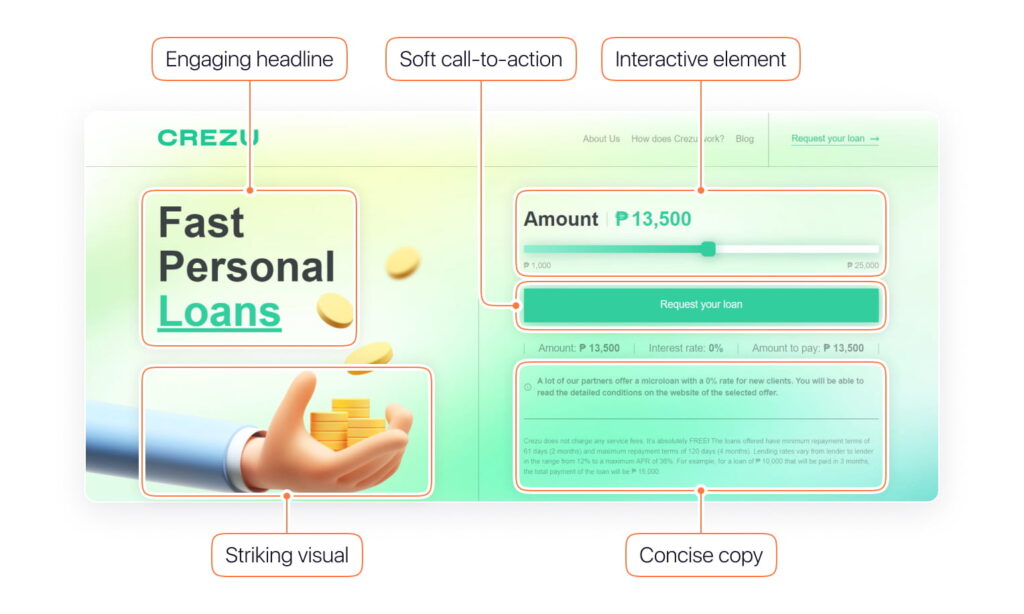In affiliate marketing, the journey from a visitor’s initial curiosity to their final commitment often begins with a crucial component: the pre-landing page. This pivotal element primes potential customers as they enter the sales funnel, ensuring that by the time they reach the main offer, they’re not just informed but are also eager to engage further. The pre-landing page sets the stage, building anticipation and interest, which is essential for a smooth transition to the deeper commitment stages that follow.
Let’s discover the pre-landing page meaning in detail.
Pre-landing pages are web pages that precede the main or target page of a website, designed to capture visitors’ attention and stimulate their interest in further content. They typically feature attractive visual elements, concise and straightforward text, as well as interactive features to create maximum impact and guide visitors towards the main content of the site.
Pre-landings are invaluable for their ability to fine-tune the traffic that reaches your main conversion points. By effectively filtering out less interested visitors, they increase the overall quality of traffic to the landing page for affiliate marketing, enhancing both the user experience and conversion rates. This selective process means that only the most engaged visitors, those who are more likely to convert, make it through to the final call to action.
Let’s take a look at what a landing page can consist of:

In affiliate marketing, a pre-landing page is a web page that precedes the actual landing page where the main offer or product is presented. Its purpose is to warm up visitors, preparing them to engage more effectively with the main content or sales offer on the landing page. Here’s a bit more about the role and benefits of pre-landing pages:
By strategically using pre-landing pages, affiliates can enhance the effectiveness of their marketing campaigns, improve user engagement, and ultimately drive better results from their promotional efforts.
Pre-landing pages come in various formats, each designed to engage visitors and guide them effectively towards the main offer.
Here are some common examples of pre-landing pages used in affiliate marketing:
These interactive pages engage users by asking them a series of questions. The answers help personalize the following content, making the main offer more appealing.

These pages use narrative techniques to connect emotionally with visitors. For instance, a pre-landing page might tell the success story of someone who used a weight loss product, setting the stage for the product’s introduction on the landing page.

Offering a free download, such as an eBook, a whitepaper, or a cheat sheet, in exchange for contact information. This not only generates leads but also provides value, making the visitor more receptive to subsequent offers.

Other ideas for pre-landing pages:
Each type of pre-landing page aims to make the transition to the landing page smooth and effective, ensuring visitors are warmed up and more likely to engage with the main call to action.
The journey begins with the pre-landing page, which not only captivates but also segments potential customers by interest or intent, using tailored messaging that resonates with each visitor. This targeting is essential to warming up the audience, ensuring that they are not only curious but also ready to engage once they reach the landing page.
The conversion strategy begins once the visitor reaches the landing page. This page builds on the pre-landing page, offering deeper insights into the product or service and calling for action. Trust-building elements like testimonials, detailed benefits, and robust features guide the visitor toward making a well-informed decision.

Depending on the affiliate marketing niche, there are different top angles to advertise the offer. The way you build pages varies even within a niche because each product requires its own style.
In affiliate marketing, the journey from a visitor’s initial curiosity to their final commitment often begins with a crucial component: the pre-landing page. This pivotal element primes potential customers as they enter the sales funnel, ensuring that by the time they reach the main offer, they’re not just informed but are also eager to engage further. The pre-landing page sets the stage, building anticipation and interest, which is essential for a smooth transition to the deeper commitment stages that follow.
Let’s discover the pre-landing page meaning in detail.
Pre-landing pages are web pages that precede the main or target page of a website, designed to capture visitors’ attention and stimulate their interest in further content. They typically feature attractive visual elements, concise and straightforward text, as well as interactive features to create maximum impact and guide visitors towards the main content of the site.
Pre-landings are invaluable for their ability to fine-tune the traffic that reaches your main conversion points. By effectively filtering out less interested visitors, they increase the overall quality of traffic to the landing page for affiliate marketing, enhancing both the user experience and conversion rates. This selective process means that only the most engaged visitors, those who are more likely to convert, make it through to the final call to action.
Let’s take a look at what a landing page can consist of:

In affiliate marketing, a pre-landing page is a web page that precedes the actual landing page where the main offer or product is presented. Its purpose is to warm up visitors, preparing them to engage more effectively with the main content or sales offer on the landing page. Here’s a bit more about the role and benefits of pre-landing pages:
By strategically using pre-landing pages, affiliates can enhance the effectiveness of their marketing campaigns, improve user engagement, and ultimately drive better results from their promotional efforts.
Pre-landing pages come in various formats, each designed to engage visitors and guide them effectively towards the main offer.
Here are some common examples of pre-landing pages used in affiliate marketing:
These interactive pages engage users by asking them a series of questions. The answers help personalize the following content, making the main offer more appealing.

These pages use narrative techniques to connect emotionally with visitors. For instance, a pre-landing page might tell the success story of someone who used a weight loss product, setting the stage for the product’s introduction on the landing page.

Offering a free download, such as an eBook, a whitepaper, or a cheat sheet, in exchange for contact information. This not only generates leads but also provides value, making the visitor more receptive to subsequent offers.

Other ideas for pre-landing pages:
Each type of pre-landing page aims to make the transition to the landing page smooth and effective, ensuring visitors are warmed up and more likely to engage with the main call to action.
The journey begins with the pre-landing page, which not only captivates but also segments potential customers by interest or intent, using tailored messaging that resonates with each visitor. This targeting is essential to warming up the audience, ensuring that they are not only curious but also ready to engage once they reach the landing page.
The conversion strategy begins once the visitor reaches the landing page. This page builds on the pre-landing page, offering deeper insights into the product or service and calling for action. Trust-building elements like testimonials, detailed benefits, and robust features guide the visitor toward making a well-informed decision.

Depending on the affiliate marketing niche, there are different top angles to advertise the offer. The way you build pages varies even within a niche because each product requires its own style.